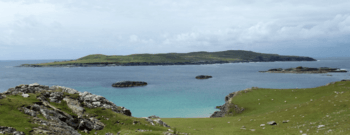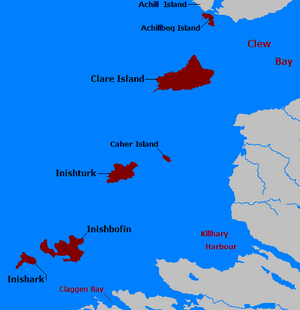Inishark facts for kids
|
Native name:
Inis Airc
Nickname: Shark
|
|
|---|---|

Inishark seen from Inishbofin
|
|
| Geography | |
| Location | Atlantic Ocean |
| Coordinates | 53°36′42″N 10°16′58″W / 53.6117°N 10.2828°W |
| Archipelago | Offshore islands of Ireland |
| Area | 2.489 km2 (0.961 sq mi) |
| Highest elevation | 96.6 m (316.9 ft) |
| Administration | |
| Province | Connacht |
| County | Galway |
| Civil parish | Inishbofin |
| Demographics | |
| Population | 0 (2011) |
| Ethnic groups | Irish (formerly) |
Inishark or Inishshark (Irish: Inis Airc), also called Shark Island, is a small island. It is located next to the bigger island of Inishbofin in County Galway, Ireland.
About Inishark Island

Today, no one lives on Inishark. The last 23 people who lived there were moved to the mainland on October 20, 1960. They were part of a small community that fished and farmed.
In winter, the islanders were often stuck and could not leave for months. The government decided it was better to move them. Building a pier (a landing place for boats) on the island would have been too expensive.
Inishark is almost 100 meters (about 328 feet) above sea level. It is mostly made of a type of rock called slate and shale.
A documentary film called Inis Airc, Bás Oileáin (which means Inishark, Death of an Island) was made in 2007. It tells the story of the island's last years and why people left. The film included interviews with people who used to live there. It also showed old news videos of the final move.
In 2009, Boston College showed this film. It was part of a series about Irish studies. The film helped share the story of the islanders leaving their home.
Inishark's Past
People have lived on Inishark for thousands of years. There are many old sites from the Bronze Age on the island. These include ancient burial grounds and monuments.
The name Inishark comes from the Irish name Inis Airc. Some people think it might be named after an old chief or king called Erc. Others believe the name is linked to the Irish word seirce, meaning "love." It could also come from airc, meaning "hardship" or "strait."
The island had a special saint named Leo of Inis Airc. He lived there sometime between the 500s and 700s. You can still see the remains of a church from the 1800s on the island. It was named after him.
In 1949, on Easter Sunday, three young islanders drowned. They were traveling to Inishbofin for church. Soon after, the island was cut off by bad weather. Another young man died from a serious illness. These sad events, along with people moving away, made many want to leave the island. By then, very few young people were left.
Island Population Changes
This table shows how the number of people living on Inishark changed over time. The information comes from a book called Discover the Islands of Ireland and from the official count of people in Ireland, called the Census. Before 1841, the census data in Ireland might not be complete or fully correct.
| Historical population | ||||||||||||||||||||||||||||||||||||||||||||||||||||||||||||||||||||||||||||||||||||||
|---|---|---|---|---|---|---|---|---|---|---|---|---|---|---|---|---|---|---|---|---|---|---|---|---|---|---|---|---|---|---|---|---|---|---|---|---|---|---|---|---|---|---|---|---|---|---|---|---|---|---|---|---|---|---|---|---|---|---|---|---|---|---|---|---|---|---|---|---|---|---|---|---|---|---|---|---|---|---|---|---|---|---|---|---|---|---|
|
|
|
||||||||||||||||||||||||||||||||||||||||||||||||||||||||||||||||||||||||||||||||||||
| Source: | ||||||||||||||||||||||||||||||||||||||||||||||||||||||||||||||||||||||||||||||||||||||


